I first wrote this article nearly 10 years ago. Since then it has become a classic of Bouvier literature, reprinted many times. Since then I have spent nearly 5 years in Bouvier Rescue, personally rescuing, rehabilitating, and placing 3 or 4 per year and assisting in the placement of others. Very little has needed revision in this new addition.....I give my permission freely to all who wish to reprint and distribute it in hopes of saving innocent Bouviers (Ed. note: we read CBR's here!) from neglect and abandonment by those who should never have acquired them in the first place.
Interested in buying a Chesapeake Bay Retriever? You must be or you wouldn't be reading this. You've already heard how marvelous CBRs are. Well, I think you should also hear, before it's too late, that
CHESAPEAKE BAY RETRIEVERS ARE NOT THE PERFECT BREED FOR EVERYONE.
As a breed they have a few features that some people find charming, but that some people find mildly unpleasant and some people find downright intolerable.
There are different breeds for different needs. There are over 200 purebred breeds of dogs in the world. Maybe you'd be better off with some other breed. Maybe you'd be better off with a cat. Maybe you'd be better off with goldfish, a parakeet, a hamster, or some house plants.
DON'T GET A CHESAPEAKE BAY RETRIEVER if you are attracted to the breed chiefly by its appearance. From a distance, the appearance of the CBRs you have seen may indicate that they are a chocolate, wavy-haired version of a Labrador Retriever. They are the largest of the retriever breeds and are not from the same lineage as a Labrador - the breedings are entirely different.
Chesapeake Bay retrievers are not related to Goldens or Labradors - and because of this very basic genetic difference, you cannot compare Chessies to these breeds. Chesapeake Bay Retrievers are the result of crosses with Newfoundlands, hounds, setters, water spaniels and other dogs and were first recognized as a distinct breed in America in the middle of the 19th century. They were ducking dogs used by market hunters for retrieving waterfowl and protecting the day’s catch. These early objectives in breeding and selecting for outstanding ducking dogs has endured in today’s Chessies - they are still remarkably tough working dogs and loyal, protective companions. Chessies are not "happy-go lucky" retrievers - they will not "love" everyone they meet. They are indifferent to other people and dogs - very different from Goldens and Labradors. Chesapeakes are unique, intensely loyal, protective, sensitive, and serious dogs - traits that require thoughtful consideration before adopting a dog.
DON'T GET A CHESAPEAKE BAY RETRIEVER if you don't intend to educate (train) your dog. Basic obedience and household rules training is not optional for the Chesapeake Bay Retriever. As an absolute minimum, you must teach him to reliably respond to commands to come, to lie down, to stay, and to walk at your side, on or off leash and regardless of temptations. You must also teach him to respect your household rules: e.g., is he allowed to get on the furniture? Is he allowed to beg at the table? What you allow or forbid is unimportant; but it is critical that you, not the dog, make these choices and that you enforce your rules consistently. You must commit yourself to attending an 8 to 10 week series of weekly lessons at a local obedience club or professional trainer and to doing one or two short (5 to 20 minutes) homework sessions per day. As commands are learned, they must be integrated into your daily life by being used whenever appropriate and enforced consistently.
Young CBR puppies are relatively easy to train: they are eager to please, intelligent, and calm-natured, with a relatively good attention span. Once a CBR has learned something, he tends to retain it well. Your cute, sweet little Chessie puppy will grow up to be a large, powerful dog with a highly self-assertive personality and the determination to finish whatever he starts. If he has grown up respecting you and your rules, then all his physical and mental strength will work for you. But if he has grown up without rules and guidance from you, surely he will make his own rules, and his physical and mental powers will often act in opposition to your needs and desires. For example: he may tow you down the street as if competing in a sled-dog race; he may grab food off the table; he may forbid your guests entry to his home. This training cannot be delegated to someone else, e.g., by sending the dog away to "boarding school," because the relationship of respect and obedience is personal between the dog and the individual who does the training. This is true of all dogs to a greater or lesser degree, but definitely to a very great degree in CBRs. While you definitely may want the help of an experienced trainer to teach you how to train your dog, you yourself must actually train your Chessie. As each lesson is well learned, then the rest of the household (except young children) must also work with the dog, insisting he obey them as well.
Many of the Chesapeakes that are rescued from pounds and shelters show clearly that they have received little or no basic training, neither in obedience nor in household deportment; yet these same dogs respond well to such training by the rescuer or the adopter. It seems likely that a failure to train the dog is a significant cause of CBR abandonment. If you don't intend to educate your dog, preferably during puppyhood, you would be better off with a breed that is both small and socially submissive, e.g., a Shetland Sheepdog. Such a dog does require training, but a little bit goes further than with a Chessie. Chessies can, with adequate training, excel at such working competitions as field trials and hunt tests, obedience, agility, and tracking.
DON'T BUY A CHESAPEAKE BAY RETRIEVER if you lack leadership (self-assertive) personality. Dogs do not believe in social equality. They live in a social hierarchy led by a pack-leader (Alpha). The alpha dog is generally benevolent, affectionate, and non-bullying towards his subordinates; but there is never any doubt in his mind or in theirs that the alpha is the boss and makes the rules. Whatever the breed, if you do not assume the leadership, the dog will do so sooner or later, and with more or less unpleasant consequences for the abdicating owner. Like the untrained dog, the pack leader dog makes his own rules and enforces them against other members of the household by means of a dominant physical posture and a hard-eyed stare, followed by a snarl, then a knockdown blow or a bite. Breeds differ in tendencies towards social dominance; and individuals within a breed differ considerably.
Chesapeakes as a breed tend to be of a socially dominant personality. You really cannot afford to let a Chesapeake become your boss. You do not have to have the personality or mannerisms of a Marine boot camp Sergeant, but you do have to have the calm, quiet self-assurance and self assertion of the successful parent ("Because I'm your mother, that's why.") or successful grade-school teacher. If you think you might have difficulty asserting yourself calmly and confidently to exercise leadership, then choose a breed known for its socially subordinate disposition, such as a Golden Retriever or a Shetland Sheepdog, and be sure to ask the breeder to select one of the more submissive pups in the litter for you. If the whole idea of "being the boss" frightens or repels you, don't get a dog at all. Cats don't expect leadership. A caged bird or hamster, or fish doesn't need leadership or household rules. Leadership and training are inextricably intertwined: leadership personality enables you to train your dog, and being trained by you reinforces your dog's perception of you as the alpha.
DON'T BUY A CHESAPEAKE BAY RETRIEVER if you want a totally unaggressive and unprotective dog. Most Chessies have an assertive and confident personality. When confronted with a threat, a proper Chesapeake Bay Retriever will be somewhat more ready to fight than to flee. Thus he may respond aggressively in situations where many other breeds back down. Most CBRs have some inclination to act aggressively to repel intruders on their territory (i.e.,your home) and to counteract assaults upon their packmates (you and your family). Without training and leadership from you to guide him, the dog cannot judge correctly whom to repel and whom to tolerate. Without training and leadership, sooner or later he may injure an innocent person who will successfully sue you for more than you own. With good training and leadership from you, he can be profoundly valuable as a defender of your home and family. (See also remarks on stability and socialization below.)
If you feel no need of an assertive dog, if you are embarrassed by a barking dog at your door, or if you have the slightest doubts of your ability and willingness to supply the essential socialization, training and leadership, then please choose one of the many breeds noted for thoroughly unaggressive temperament, such as a Sheltie or a Golden Retriever.
DON'T GET A CHESAPEAKE BAY RETRIEVER if you are unwilling to share your house and your life with your dog. Chessies were bred to share in the work of the family and to spend most of their waking hours working with the family. They thrive on companionship and they want to be wherever you are. They are happiest living with you in your house and going with you when you go out. While they usually tolerate being left at home by themselves, they should not be relegated to the backyard or kennel. A puppy exiled from the house is likely to grow up to be unsociable (fearful and/or unprovokedly aggressive), unruly, and unhappy. He may well develop pastimes, such as digging or barking, that will displease you and/or your neighbors. An adult so exiled will be miserable too. If you don't strongly prefer to have your dog's companionship as much as possible, enjoying having him sleep in your bedroom at night and sharing many of your activities by day, you should choose a breed less oriented to human companionship. Likewise, if your job or other obligations prevent you from spending much time with your dog. No dog is really happy without companionship, but the pack hounds are more tolerant of being kenneled or yarded so long as it is in groups of 2 or more. A better choice would be a cat, as they are solitary by nature.
DON'T GET A CHESAPEAKE BAY RETRIEVER if you don't value laid-back companionship and calm affection. A Chessie becomes deeply attached and devoted to his own family, but he doesn't "wear his heart on his sleeve." Some are noticeably reserved, others are more outgoing, but few adults are usually exuberantly demonstrative of their affection. They make remarkable eye contact with their favorite people. They like to be near you, usually in the same room, preferably on a comfortable pad or cushion in a corner or under a table, just "keeping you company." They enjoy conversation, petting and cuddling when you offer it, but they are moderate and not overbearing in coming to you to demand much attention. They are emotionally sensitive to their favorite people: when you are joyful, proud, angry, or grief-stricken, your CBR will immediately perceive it and will believe himself to be the cause. The relationship can be one of great mellowness, depth and subtlety; it is a relation on an adult-to-adult level, although certainly not one devoid of playfulness - Chessies are famous for their vocalization with their people (the "roo-roo-roos" and the snorts). As puppies, of course, they will be more dependent, more playful, and more demonstrative. In summary, Chesapeakes tend to be sober and thoughtful, rather than giddy clowns or synchophants. A number of breeds retain into adulthood a more puppyish and playful disposition, e.g., Australian Shepherds, Malamutes, and others. Quite a few are far more dramatically demonstrative and/or more clingingly dependent, e.g., the Golden Retriever.
DON'T GET A CHESAPEAKE BAY RETRIEVER if you are fastidious about the neatness of your home. The CBR’s unique, water-repellent coat and his love of playing in water combine to make him a highly efficient transporter of dirt into your home, depositing same on your floors and rugs and possibly also on your furniture and clothes. You must realize that you should be prepared to get wet when you and your Chessie are near water. Although it is technically true that CBRs do not shed long coats and do not require professional grooming, they do "blow coat" at least twice a year and your house will be full of brown "dust bunnies" tumbleweeding their way about your house. I don't mean to imply that you must be a slob or slattern to live happily with a Chessie, but you do have to have the attitude that your dog's company means more to you than does neatness and you do have to be comfortable with a less than immaculate house. All dogs, like all children, create a greater or lesser degree of household mess. The Basenji is perhaps the cleanest, due to its cat-like habits; but cats are cleaner yet, and goldfish hardly ever mess up the house.
DON'T GET A CHESAPEAKE BAY RETRIEVER if you dislike daily physical exercise. Chessies need exercise to maintain the health of heart and lungs and to maintain muscle tone. An adult CBR should have a morning outing of a mile or more, as you walk briskly, jog, or bicycle beside him, and a similar evening outing. For puppies, shorter and slower walks, several times a day are preferred for exercise and housebreaking. But, more than just walks, you need to "work" your Chessie. Chesapeakes were bred to work hard and the modern dogs still thrive on work. Anyone who owns one should be able to devote at least 20 minutes a day either working, training, retrieving or playing with them. Chesapeakes that are not worked - both physically and mentally - are prone to mischief and will not "think." Because of their love of water, 20 minutes of water retrieves is usually much more intense work than an hour walking around the neighborhood nicely on the leash. These active, intelligent dogs need jobs and responsibilities - it is best if you designate what these jobs are - you might not agree with what your Chessie decides is important!
All dogs need daily exercise of greater or lesser length and vigor. If providing this exercise and work is beyond you, physically or temperamentally, then choose one of the many small and energetic breeds that can exercise itself within your fenced yard. Most of the Toys and Terriers fit this description, but don't be surprised if a Terrier is inclined to dig in the earth since digging out critters is the job that they were bred to do. Cats can be exercised indoors with mouse-on-a-string toys. Hamsters will exercise themselves on a wire wheel. House plants don't need exercise.
DON'T GET A CHESAPEAKE BAY RETRIEVER if you believe that dogs should run "free." Whether you live in town or country, no dog can safely be left to run "free" outside your fenced property and without your direct supervision and control. The price of such "freedom" is inevitably injury or death: from dogfights, from automobiles, from the Pound or from justifiably irate neighbors. Even though Chessies are home-loving and less inclined to roam than most breeds, an unfenced CBR is destined for disaster. The unfenced city CBR is likely to exercise his inherited retrieving instinct on joggers, bicyclists, and automobiles. A thoroughly obedience-trained Chesapeake Bay Retriever can enjoy the limited and supervised freedom of off-leash walks with you in appropriately chosen environments. If you don't want the responsibility of confining and supervising your pet, then no breed of dog is suitable for you. A neutered cat will survive such irresponsibly given "freedom" somewhat longer than a dog, but will eventually come to grief. A better answer for those who crave a "free" pet is to set out feeding stations for some of the indigenous wildlife, such as raccoons, which will visit for handouts and which may eventually tolerate your close observation.
DON'T GET A CHESAPEAKE BAY RETRIEVER if you can't afford to buy, feed, and provide health care for one. Chesapeakes are not a cheap breed to buy, as running a careful breeding program with due regard for temperament, trainability, and physical soundness (hips & eyes especially) cannot be done cheaply. The time the breeder should put into each puppy's "pre-school" and socialization is also costly. The "bargain" puppy from a "back-yard breeder" who unselectively mates any two CBRs who happen to be of opposite sex may well prove to be extremely costly in terms of bad temperament, bad health, and lack of essential socialization. In contrast, the occasional adult or older pup is available at modest price from a disenchanted owner or from a breeder, shelter, or rescuer to whom the dog was abandoned; most of these "used" Chessies are capable of becoming a marvelous dog for you if you can provide training,leadership, and understanding. Whatever the initial cost of your Chessie, the upkeep will not be cheap.
Being large dogs, CBRs eat relatively large meals. (Need I add that what goes in one end must eventually come out the other?) Large dogs tend to have larger veterinary bills, as the amount of anesthesia and of most medications is proportional to body weight. Spaying or neutering, which costs more for larger dogs, is an essential expense for virtually all pet CBRs, as it "takes the worry out of being close", prevents serious health problems in later life, and makes the dog a more pleasant companion. Chessies are subject to hip dysplasia which can be costly to treat. (Your best insurance against dysplasia is to buy only from a litter bred from OFA-certified parents and (if possible), grandparents. Yes, this generally means paying more. Finally, the modest fee for participation in a series of basic obedience training classes is an essential investment in harmonious living with your dog; such fees are the same for all breeds, although conceivably you will need to travel a bit further from home to find a training class teacher who is competent with the more formidable breeds, such as the Chesapeake. The modest annual outlays for immunizations and for local licensing are generally the same for all breeds, although some counties have a lower license fee for spayed/neutered dogs. All dogs, of whatever breed and however cheaply acquired, require significant upkeep costs, and all are subject to highly expensive veterinary emergencies. Likewise all cats.
DON'T GET A CHESAPEAKE BAY RETRIEVER if you want the "latest, greatest ferocious killer attack dog". Although the Chesapeake has been bred to be protective of his owner’s home, and he may be described as the "Rottweiler of the retrievers," the CBR is less capable in these respects than half a dozen other protection breeds. CBRs must have great respect for the leadership of his handler and must be solidly trained in basic obedience to that handler. Equally essential, he must have a rock-solidly stable temperament and he must also have been "socialized" out in the world enough to know that most people are friendly and harmless, so that he can later learn to distinguish the bad guys from the good guys. Please don't buy any dog for protection training unless you are absolutely committed to the extreme amount of work that will be required of you personally. Also talk to your lawyer and your insurance agent first. In contrast to the protection-trained dog, trained to bite on direct command or in reaction to direct physical assault on his master, the "deterrent dog" dissuades the vast majority of aspiring burglars, rapists, and assailants by his presence, his appearance, and his demeanor. Seeing such a dog, the potential wrong-doer simply decides to look for a safer victim elsewhere. For this job, all that is needed is a dog that is large and that appears to be well-trained and unafraid. CBR’s are suited to this type of protection, since they usually bark at people who approach the property or the home. On a leash, however, most people equate the CBR with the Labrador, a notoriously friendly dog.
Other breeds of dog which are suitable for protection or for deterrence include the Doberman, Rottweiler, German Shepherd, Briard, Belgian Sheepdog, Belgian Tervuren, and Belgian Malinois. Of these the first 3 are recognized by the general public as "police dogs" and are probably far more feared by most potential criminals would be by a Chesapeake. The Malamute, though not suitable for protection, is quite effective for deterrence due to his highly wolf-like appearance.
DON'T GET A CHESAPEAKE BAY RETRIEVER if you are not willing to commit yourself for the dog's entire lifetime. No dog deserves to be cast out because his owners want to move to a no-pet apartment or because he is no longer a cute puppy or didn't grow up to be a beauty contest winner or because his owners through lack of leadership and training have allowed him to become an unruly juvenile delinquent with a repertoire of undesirable behaviors. The prospects of a responsible and affectionate second home for a "used"
dog are never very bright, but they are especially dim for a large, poorly mannered dog. A Chesapeake dumped into a Pound or Shelter has almost no chance of survival unless he has the great good fortune to be spotted by someone dedicated to Chesapeake Bay Retriever Rescue. The prospects for adoption for a youngish, well-trained, CBR whose owner seeks the assistance of the nearest CBR Club or Rescue group are fairly good; but an older Chessie has diminishing prospects. Be sure to contact your local American Chesapeake breeder or Rescue group if you are diagnosed as terminally ill or have other equally valid reason for seeking an adoptive home. Be sure to contact your local Chessie breeder or rescuer if you are beginning to have difficulties in training your Chessie, so these can be resolved. Be sure to make arrangements in your will or with your family to ensure continued care or adoptive home for your Chessie if you should pre-decease him.
The life span of a Chesapeake Bay Retriever is from 10 to 15 years. If that seems too long a time for you to give an unequivocal loyalty to your Chessie, then please do not get one! Indeed, as most dogs have a life expectancy that is as long or longer, please do not get any dog!
IN CONCLUSION
If all the preceding "bad news" about Chessies hasn't turned you away from the breed, then by all means DO GET A CHESAPEAKE BAY RETRIEVER! They are every bit as wonderful as you have heard!
If buying a puppy, be sure to shop carefully for a responsible and knowledgeable breeder who places high priority on breeding for sound temperament and trainability and good health in all matings. Such a breeder will interrogate and educate potential buyers carefully. Such a breeder will continue to be available for advice and consultation for the rest of the puppy's life and will insist on receiving the dog back if ever you are unable to keep it.
However as an alternative to buying a Chessie puppy, you may want to give some serious consideration to adopting a rescued CBR. Despite the irresponsibility of their previous owner, rescued CBRs have proven to be rehabilitated so as to become superb family companions for responsible and affectionate adopters. Many rescuers are skilled trainers who evaluate temperament and provide remedial training before offering dogs for placement, and who offer continued advisory support afterwards. Contact the Chesapeake Bay Retriever Rescue & Relief home page (cbrrescue.org) or a local breeder to learn who is doing Rescue work.




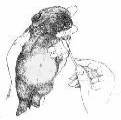
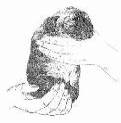 Figure 2
Figure 2 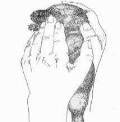
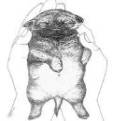
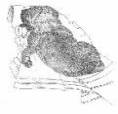 Figure 5
Figure 5